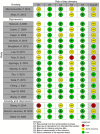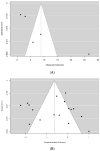Effect of Dancing Interventions on Depression and Anxiety Symptoms in Older Adults: A Systematic Review and Meta-Analysis
- PMID: 38247695
- PMCID: PMC10813489
- DOI: 10.3390/bs14010043
Effect of Dancing Interventions on Depression and Anxiety Symptoms in Older Adults: A Systematic Review and Meta-Analysis
Abstract
This systematic review and meta-analysis (PROSPERO CRD42023428105) investigated the effect of dancing on depression and anxiety symptoms in older adults. Conducted up to October 2023, the search across seven databases and gray literature yielded 5020 records. Only randomized trials that analyzed dance interventions for depression and/or anxiety in older adults were included. Nineteen randomized trials, involving 508 participants in dance classes lasting 5 weeks to 18 months, were included and 16 were subjected to meta-analysis. Risk of bias was assessed using the Cochrane tool. The meta-analysis showed a statistically significant reduction in depression among older adults participating in dance interventions (p < 0.01). A decrease in depressive symptoms was significant compared to that in those involved in no other intervention (p = 0.02) but not compared to that achieved with other interventions in control groups (p = 0.96). Subgroup analysis showed no significant differences in depression scores for those with mild cognitive impairment (p = 0.47). These conclusions are associated with moderate bias and very low certainty. Due to heterogeneity and the small number of studies, conclusions for anxiety outcomes could not be drawn. These results underscore the potential clinical relevance of integrating dance into mental health interventions for older adults, thereby highlighting a promising avenue for enhancing the mental well-being of this demographic.
Keywords: aged; aging; anxiety; cognitive impairment; dancing; depression; physical exercise; psychology; quality of life.
Conflict of interest statement
The authors declare no conflicts of interest.
Figures





Similar articles
-
Effectiveness of Dance-Based Interventions on Depression for Persons With MCI and Dementia: A Systematic Review and Meta-Analysis.Front Psychol. 2022 Jan 5;12:709208. doi: 10.3389/fpsyg.2021.709208. eCollection 2021. Front Psychol. 2022. PMID: 35069306 Free PMC article.
-
Psychosocial interventions for preventing and treating depression in dialysis patients.Cochrane Database Syst Rev. 2019 Dec 2;12(12):CD004542. doi: 10.1002/14651858.CD004542.pub3. Cochrane Database Syst Rev. 2019. PMID: 31789430 Free PMC article.
-
Evidence of the Effects of Dance Interventions on Adults Mental Health: A Systematic Review.J Dance Med Sci. 2023 Dec;27(4):183-193. doi: 10.1177/1089313X231178095. Epub 2023 Jun 7. J Dance Med Sci. 2023. PMID: 37287281
-
Dancing for Healthy Aging: Functional and Metabolic Perspectives.Altern Ther Health Med. 2019 Jan;25(1):44-63. Altern Ther Health Med. 2019. PMID: 29428927 Review.
-
Internet and Computer-Based Cognitive Behavioral Therapy for Anxiety and Depression in Adolescents and Young Adults: Systematic Review and Meta-Analysis.J Med Internet Res. 2020 Sep 25;22(9):e17831. doi: 10.2196/17831. J Med Internet Res. 2020. PMID: 32673212 Free PMC article.
Cited by
-
The effect of dance interventions on well-being dimensions in older adults: a systematic review.Front Sports Act Living. 2025 Jul 25;7:1594754. doi: 10.3389/fspor.2025.1594754. eCollection 2025. Front Sports Act Living. 2025. PMID: 40787603 Free PMC article.
-
Is physical exercise associated with reduced adolescent social anxiety mediated by psychological resilience?: evidence from a longitudinal multi-wave study in China.Child Adolesc Psychiatry Ment Health. 2025 Mar 5;19(1):17. doi: 10.1186/s13034-025-00867-8. Child Adolesc Psychiatry Ment Health. 2025. PMID: 40045423 Free PMC article.
References
-
- Centers for Disease Control and Prevention and National Association of Chronic Disease Directors . The State of Mental Health and Aging in America Issue Brief 1: What Do the Data Tell Us? National Association of Chronic Disease Directors; Atlanta, GA, USA: 2008.
-
- Heissel A., Heinen D., Brokmeier L.L., Skarabis N., Kangas M., Vancampfort D., Stubbs B., Firth J., Ward P.B., Rosenbaum S., et al. Exercise as Medicine for Depressive Symptoms? A Systematic Review and Meta-Analysis with Meta-Regression. Br. J. Sports Med. 2023;57:1049–1057. doi: 10.1136/bjsports-2022-106282. - DOI - PMC - PubMed
Publication types
LinkOut - more resources
Full Text Sources
Miscellaneous

